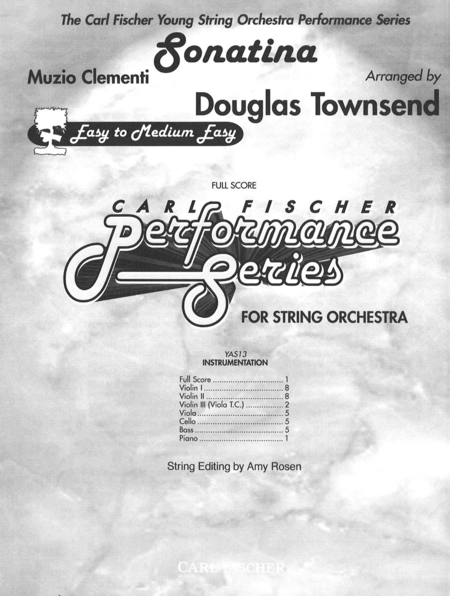Sonatina$8.00 - See more - Buy online Lead time before shipment : 1 to 2 weeks Format : Score Orchestra String Orchestra - Grade 2-2.5 Instrumentation : SKU: CF.YAS13F Composed by Muzio Clementi. Arranged by Douglas Townsend. Carl Fischer Young String Orchestra Series. Classical. Full score. With Standard notation. 12 pages. Carl Fischer Music #YAS13F. Published by Carl Fischer Music (CF.YAS13F).ISBN 9780825848339. UPC: 798408048334. 8.5 X 11 inches. Key: G major. IApart from some of his Sonatinas, Opus 36, Clementi's life and music are hardly known to the piano teachers and students of today. For example, in addition to the above mentioned Sonatinas, Clementi wrote sixty sonatas for the piano, many of them unjustly neglected, although his friend Beethoven regarded some of them very highly. Clementi also wrote symphonies (some of which he arranged as piano sonatas), a substantial number of waltzes and other dances for the piano as well as sonatas and sonatinas for piano four-hands.In addition to composing, Clementi was a much sought after piano teacher, and included among his students John Field (Father of the 'Nocturne'), and Meyerbeer.In his later years, Clementi became a very successful music publisher, publishing among other works the first English edition of Beethoven's Violin Concerto, in the great composer's own arrangement for the piano, as well as some of his string quartets. Clementi was also one of the first English piano manufacturers to make pianos with a metal frame and string them with wire.The Sonatina in C, Opus 36, No. 1 was one of six such works Clementi wrote in 1797. He must have been partial to these little pieces (for which he also provided the fingerings), since they were reissued (without the fingering) by the composer shortly after 1801. About 1820, he issued ''the sixth edition, with considerable improvements by the author;· with fingerings added and several minor changes, among which were that many of them were written an octave higher.IIIt has often been said, generally by those unhampered by the facts, that composers of the past (and, dare we add, the present?), usually handled their financial affairs with their public and publishers with a poor sense of business acumen or common sense. As a result they frequently found themselves in financial straits.Contrary to popular opinion, this was the exception rather than the rule. With the exception of Mozart and perhaps a few other composers, the majority of composers then, as now, were quite successful in their dealings with the public and their publishers, as the following examples will show.It was not unusual for 18th- and 19th-century composers to arrange some of their more popular compositions for different combinations of instruments in order to increase their availability to a larger music-playing public. Telemann, in the introduction to his seventy-two cantatas for solo voice and one melody instrument (flute, oboe or violin, with the usual continua) Der Harmonische Gottesdienst, tor example, suggests that if a singer is not available to perform a cantata the voice part could be played by another instrument. And in the introduction to his Six Concertos and Six Suites for flute, violin and continua, he named four different instrumental combinations that could perform these pieces, and actually wrote out the notes for the different possibilities. Bach arranged his violin concertos for keyboard, and Beethoven not only arranged his Piano Sonata in E Major, Opus 14, No. 1 for string quartet, he also transposed it to the key of F. Brahm's well-known Quintet in F Minor for piano and strings was his own arrangement of his earlier sonata for two pianos, also in F Minor.IIIWe come now to Clementi. It is well known that some of his sixty piano sonatas were his own arrangements of some of his lost symphonies, and that some of his rondos for piano four-hands were originally the last movements of his solo sonatas or piano trios.In order to make the first movement of his delightful Sonatina in C, Opus 36, No. 1 accessible to young string players, I have followed the example established by the composer himself by arranging and transposing one of his piano compositions from one medium (the piano) to another. (string instruments). In order to simplify the work for young string players, in the process of adapting it to the new medium it was necessary to transpose it from the original key of C to G, thereby doing away with some of the difficulties they would have encountered in the original key. The first violin and cello parts are similar to the right- and left-hand parts of the original piano version. The few changes I have made in these parts have been for the convenience of the string players, but in no way do they change the nature of the music.Since the original implied a harmonic framework in many places, I have added a second violin and viola part in such a way that they not only have interesting music to play, but also fill in some of the implied harmony without in any way detracting from the composition's musical value. Occasionally, it has been necessary to raise or lower a few passages an octave or to modify others slightly to make them more accessible for young players.It is hoped that the musical value of the composition has not been too compromised, and that students and teachers will come to enjoy this little piece in its new setting as much as pianists have in the original one. This arrangement may also be performed by a solo string quartet. When performed by a string orchestra, the double bass part may be omitted.- Douglas TownsendString editing by Amy Rosen. About Carl Fischer Young String Orchestra Series This series of Grade 2/Grade 2.5 pieces is designed for second and third year ensembles. The pieces in this series are characterized by: String OrchestraPublisher : Carl FischerLevel : 
|








